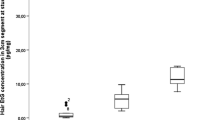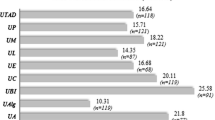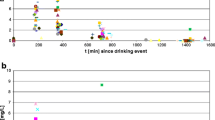Abstract
Background
Ethanol and caffeine are the most widely used psychoactive substances in the world, with an observed steady increase in the combined consumption of alcohol and caffeine. Specific signs of ethanol-caffeine interactions have been reported both in humans and in animals. The metabolic effects of these interactions have not been fully elucidated. There are no published reports on the influence of caffeine on ethyl glucuronide (EtG) formation. EtG is a direct metabolite of ethanol and is very often used as a biomarker of alcohol consumption. Here, we investigated the influence of caffeine on the formation of EtG in rat plasma and EtG incorporation into the hair.
Methods
Studies were conducted on three male Wistar rat groups, each receiving either ethanol at 3 g/kg/day, ethanol (at the same dose) with caffeine at 3 mg/kg/day, or caffeine at 3 mg/kg/day for four weeks. EtG and caffeine levels were evaluated in hair and in blood after the last administration.
Results
Blood EtG levels after the administration of ethanol together with caffeine were significantly higher than after the administration of ethanol alone. EtG levels in rat hair in the ethanol-and-caffeine group were also higher than in the ethanol-only group, but the difference was not statistically significant.
Conclusion
This study shows the possible effect of ethanol and caffeine co-administration on EtG formation. Caffeine stimulates EtG synthesis resulting in increased blood and, possibly, hair levels of this metabolite. However, the role of these changes in estimating alcohol consumption requires further studies.
Similar content being viewed by others
References
WHO Global status report on alcohol and health. Switzerland: WHO Press; 2014. p. 2014 XIV phttps://doi.org/www.who.int/substance_abuse/publications/global_alcohol_report/msb_gsr_2014_1.%20pdf?ua%E2%80%89=1.(Accesed August 2017).
Allen J.P., Litten RZ, Strid N, Sillanaukee P. The role of biomarkers in alcoholism medication trials. Alcohol Clin Exp Res 2001;25(8):1119–25.
Litten RZ, Bradley AM, Moss HB. Alcohol biomarkers in applied settings: recent advances and future research opportunities. Alcohol Clin Exp Res 2010;34(6):955–67.
Wurst FM, Skipper GE, Weinmann W. Ethyl glucuronide-the direct ethanol metabolite on the threshold from science to routine use. Addiction (Abingdon, England) 2003;98(Suppl. 2):51–61.
Crunelle CL, Cappelle D, Yegles M, De Doncker M, Michielsen P, Dom G, et al. Ethyl glucuronide concentrations in hair: a controlled alcohol-dosing study in healthy volunteers. Anal Bioanal Chem 2016;408(8):2019–25.
Andresen-Streichert H, von Rothkirch G, Vettorazzi E, Mueller A, Lohse AW, Frederking D, et al. Determination of ethyl glucuronide in hair for detection of alcohol consumption in patients after liver transplantation. Ther Drug Monit 2015;37(4):539–45.
Beckmann M, Paslakis G, Bottcher M, Helander A, Erim Y. Integration of clinical examination, self-report, and hair ethyl glucuronide analysis for evaluation of patients with alcoholic liver disease prior to liver transplantation. Prog Transpl 2016;26(1):40–6.
Politi L, Morini L, Leone F, Polettini A. Ethyl glucuronide in hair: is it a reliable marker of chronic high levels of alcohol consumption? Addiction (Abingdon, England) 2006;101(10):1408–12.
Appenzeller BM, Agirman R, Neuberg P, Yegles M, Wennig R. Segmental determination of ethyl glucuronide in hair: a pilot study. Forensic Sci Int 2007;173(2–3):87–92.
Kerekes I, Yegles M, Grimm U, Wennig R. Ethyl glucuronide determination: head hair versus non-head hair. Alcohol Alcohol 2009;44(1):62–6.
Crunelle CL, Cappelle D, Covaci A, van Nuijs AL, Maudens KE, Sabbe B, et al. Hair ethyl glucuronide as a biomarker of alcohol consumption in alcohol-dependent patients: role of gender differences. Drug Alcohol Depend 2014;141:163–6.
Morini L, Politi L, Polettini A. Ethyl glucuronide in hair. A sensitive and specific marker of chronic heavy drinking. Addiction (Abingdon, England) 2009;104(6):915–20.
Crunelle CL, Verbeek J, Dom G, Covaci A, Yegles M, Michielsen P, et al. Hair ethyl glucuronide and serum carbohydrate deficient transferrin for the assessment of relapse in alcohol-dependent patients. Clin Biochem 2016;49(7–8):554–9.
Kintz P. 2014 consensus for the use of alcohol markers in hair for assessment of both abstinence and chronic excessive alcohol consumption. Forensic Sci Int 2015;249:A1–2.
Kintz P, Salomone A, Vincenti M. Hair Analysis in Clinical and Forensic Toxicology. Elsevier Inc; 2015 eBook ISBN: 9780128017104.
Kharbouche H, Steiner N, Morelato M, Staub C, Boutrel B, Mangin P, et al. Influence of ethanol dose and pigmentation on the incorporation of ethyl glucuronide into rat hair. Alcohol (Fayetteville, NY) 2010;44(6):507–14.
Crunelle CL, Yegles M, van Nuijs AL, Covaci A, De Doncker M, Maudens KE, et al. Hair ethyl glucuronide levels as a marker for alcohol use and abuse: a review of the current state of the art. Drug Alcohol Depend 2014;134:1–11.
Morini L, Zucchella A, Polettini A, Politi L, Groppi A. Effect of bleaching on ethyl glucuronide in hair: an in vitro experiment. Forensic Sci Int 2010;198:23–7.
Crunelle CL, Yegles M, De Doncker M, Dom G, Cappelle D, Maudens KE, et al. Influence of repeated permanent coloring and bleaching on ethyl glucuronide concentrations in hair from alcohol-dependent patients. Forensic Sci Int 2014;247:18–22.
Kerekes I, Coloring Yegles M. Bleaching, and perming influence on EtG content in hair. Ther Drug Monit 2013;35(4):527–9.
Fosen JT, Morini L, Sempio C, Ganss R, Morland J, Hoiseth G. Levels of hair ethyl glucuronide in patients with decreased kidney function: possibility of misclassification of social drinkers. Alcoholism (NY) 2016;40(3):451–6.
Crunelle CL, Neels H, Maudens K, De Doncker M, Cappelle D, Matthys F, et al. Influence of body mass index on hair ethyl glucuronide concentrations. Alcohol Alcohol 2017;52(1):19–23.
Kronstrand R, Brinkhagen L, Nystrom FH. Ethyl glucuronide in human hair after daily consumption of 16 or 32 g of ethanol for 3 months. Forensic Sci Int 2011;215(1–3):51–5.
Alt A, Janda I, Seidl S, Wurst F-M. Determination of ethyl glucuronide in hair samples. Alcohol Alcohol 2000;35(3):313–4.
Hoiseth G, Morini L, Ganss R, Nordal K, Morland J. Higher levels of hair ethyl glucuronide in patients with decreased kidney function. Alcohol Clin Exp Res 2012;37(Suppl. 1):E14–6.
Sporkert F, Kharbouche H, Augsburger MP, Klemm C, Baumgartner MR. Positive EtG findings in hair as a result of a cosmetic treatment. Forensic Sci Int 2012;218(1–3):97–100.
Arndt T, Schrofel S, Stemmerich K. Ethyl glucuronide identified in commercial hair tonics. Forensic Sci Int 2013;231(1–3):195–8.
Pirro V, Di Corcia D, Seganti F, Salomone A, Vincenti M. Determination of ethyl glucuronide levels in hair for the assessment of alcohol abstinence. Forensic Sci Int 2013;232(1–3):229–36.
Martins Ferreira L, Binz T, Yegles M. The influence of ethanol containing cosmetics on ethyl glucuronide concentration in hair. Forensic Sci Int 2012;3:123–5 Abstract — Europe PMC.
Suesse S, Pragst F, Mieczkowski T, Selavka CM, Elian A, Sachs H, et al. Practical experiences in application of hair fatty acid ethyl esters and ethyl glucuronide for detection of chronic alcohol abuse in forensic cases. Forensic Sci Int 2012;218(1–3):82–91.
Paul R, Kingston R, Tsanaclis L, Berry A, Guwy A. Do drug users use less alcohol than non-drug users? A comparison of ethyl glucuronide concentrations in hair between the two groups in medico-legal cases. Forensic Sci Int 2008;176(1):82–6.
Esimone CO, Okoye FBC, Nworu CS, Agubata CO. In vitro interaction between caffeine and some penicillin antibiotics against Staphylococcus aureus. Top J Pharm Res 2008;7(2):969–74.
Sweeney MM, Meredith SE, Evatt DP, Griffiths RR. Effects of caffeine on alcohol reinforcement: beverage choice, self-administration, and subjective ratings. Psychopharmacology (Berl) 2017;234(5):877–88.
Reis R, Charehsaz M, Sipahi H, Ekici AID, Macit C, Akkaya H, et al. Energy drink induced lipid peroxidation and oxidative damage in rat liver and brain when used alone or combined with alcohol. J Food Sci 2017;82(4):1037–43.
De Kesel PM, Lambert WE, Stove CP. Paraxanthine/caffeine concentration ratios in hair: an alternative for plasma-Based phenotyping of cytochrome P450 1A2? Clin Pharmacokinet 2015;54(7):771–81.
European Medicines Agency, https://doi.org/www.ema.europa.eu/docs/en_GB/document_library/Scientific_guideline/2011/08/WC500109686.pdf. (Accesed March 2017).
Mueller A, Jungen H, Iwersen-Bergmann S, Raduenz L, Lezius S, Andresen-Streichert H. Determination of ethyl glucuronide in human hair samples: a multivariate analysis of the impact of extraction conditions on quantitative results. Forensic Sci Int 2017;271:43–8.
Sterneck M, Yegles M, von Rothkirchl G, Staufer K, Vettorazzi E, Schulz K-H, et al. Determination of ethyl glucuronide in hair improves evaluation of long-term alcohol abstention in liver transplant candidates. Liver Int 2014;34:469–76.
Malinauskas BM, Aeby VG, Overton RF, Carpenter-Aeby T, Barber-Heidal K. A survey of energy drink consumption patterns among college students. Nutr J 2007;6:35.
Oteri A, Salvo F, Caputi AP, Calapai G. Intake of energy drinks in association with alcoholic beverages in a cohort of students of the School of Medicine of the University of Messina. Alcohol Clin Exp Res 2007;31(10):1677–80.
Price SR, Hilchey CA, Darredeau C, Fulton HG, Barrett SP. Energy drink co-administration is associated with increased reported alcohol ingestion. Drug Alcohol Rev 2010;29(3):331–3.
Ferré S, O’Brien MC. Alcohol and Caffeine The Perfect Storm. J Caffeine Res 2011;1(3):153–62.
Lopez-Cruz L, San-Miguel N, Bayarri P, Baqi Y, Muller CE, Salamone JD, et al. Ethanol and caffeine effects on social interaction and recognition in mice: involvement of adenosine A2A and A1 receptors. Front Behav Neurosci 2016;10:206, doi:https://doi.org/10.3389/fnbeh.2016.00206.
Marczinski CA, Fillmore MT. Clubgoers and their trendy cocktails: implications of mixing caffeine into alcohol on information processing and subjective reports of intoxication. Exp Clin Psychopharmacol 2006;14(4):450–8.
Gasior M, Jaszyna M, Peters J, Goldberg SR. Changes in the ambulatory activity and discriminative stimulus effects of psychostimulant drugs in rats chronically exposed to caffeine: effect of caffeine dose. J Pharmacology Exp Ther 2000;295(3):1101–11.
Azcona O, Barbanoj MJ, Torrent J, Jané F. Evaluation of the central effects of alcohol and caffeine interaction. Br J Clin Pharmacol 1995;40(4):393–400.
Kot M, Daniel WA. Caffeine as a marker substrate for testing cytochrome P450 activity in human and rat. Pharmacol Rep 2008;60(6):789–97.
Gu L, Gonzalez FJ, Kalow W, Tang BK. Biotransformation of caffeine, paraxanthine, theobromine and theophylline by cDNA-expressed human CYP1A2 and CYP2E1. Pharmacogenetics 1992;2(2):73–7.
Mitchell Jr. MC, Teigen EL, Ramchandani VA. Absorption and peak blood alcohol concentration after drinking beer, wine, or spirits. Alcohol Clin Exp Res 2014;38(5):1200–4.
Al Saabi A, Allorge D, Sauvage FL, Tournel G, Gaulier JM, Marquet P, et al. Involvement of UDP-glucuronosyltransferases UGT1A9 and UGT2B7 in ethanol glucuronidation, and interactions with common drugs of abuse. Drug Metab Dispos 2013;41(3):568–74.
Schwab N, Skopp G. Identification and preliminary characterization of UDP-glucuronosyltransferases catalyzing formation of ethyl glucuronide. Anal Bioanal Chem 2014;406(9–10):2325–32.
Stachel N, Skopp G. Formation and inhibition of ethyl glucuronide and ethyl sulfate. Forensic Sci Int 2016;265:61–4.
Author information
Authors and Affiliations
Corresponding author
Rights and permissions
About this article
Cite this article
Małkowska, A., Bamburowicz-Klimkowska, M., Łukasik, M. et al. The influence of caffeine on ethyl glucuronide levels in rat serum and in rat hair. Pharmacol. Rep 70, 831–836 (2018). https://doi.org/10.1016/j.pharep.2018.02.002
Received:
Revised:
Accepted:
Published:
Issue Date:
DOI: https://doi.org/10.1016/j.pharep.2018.02.002




